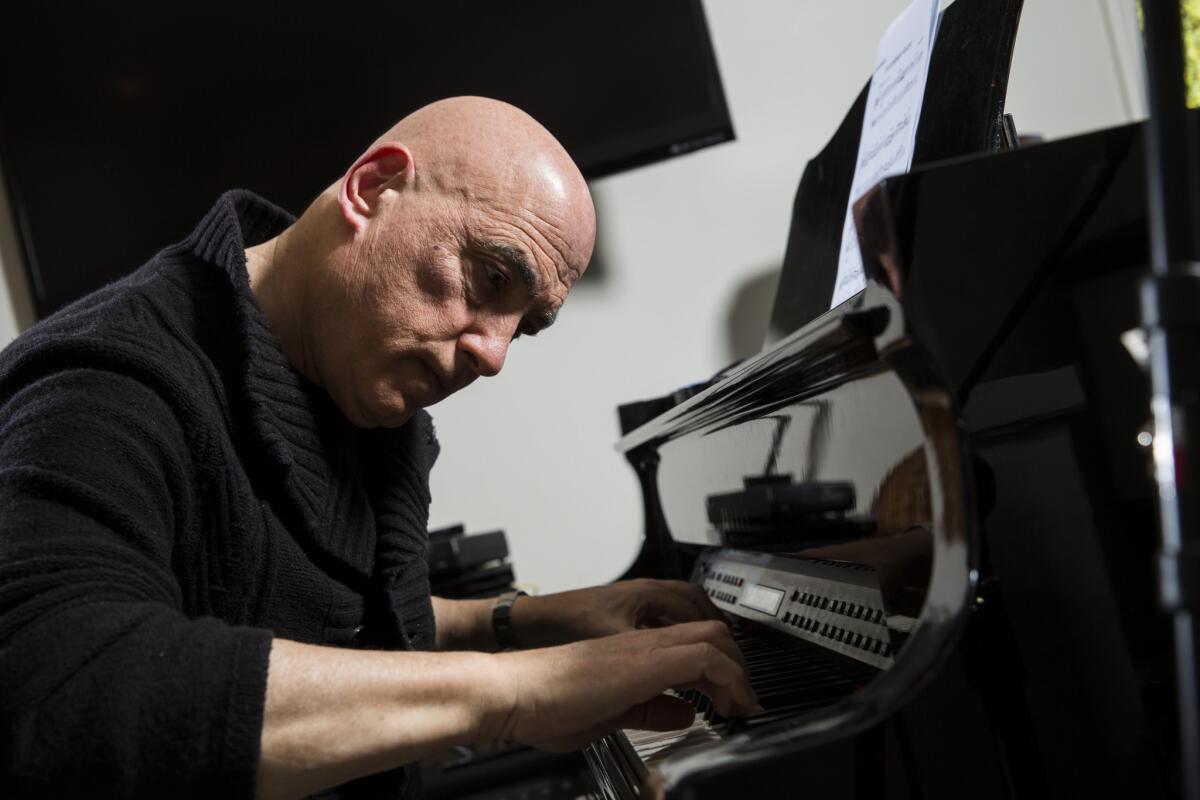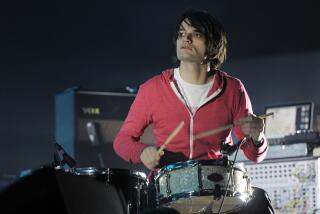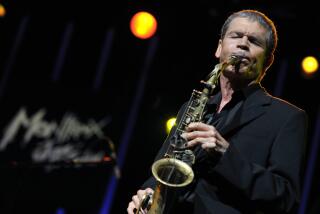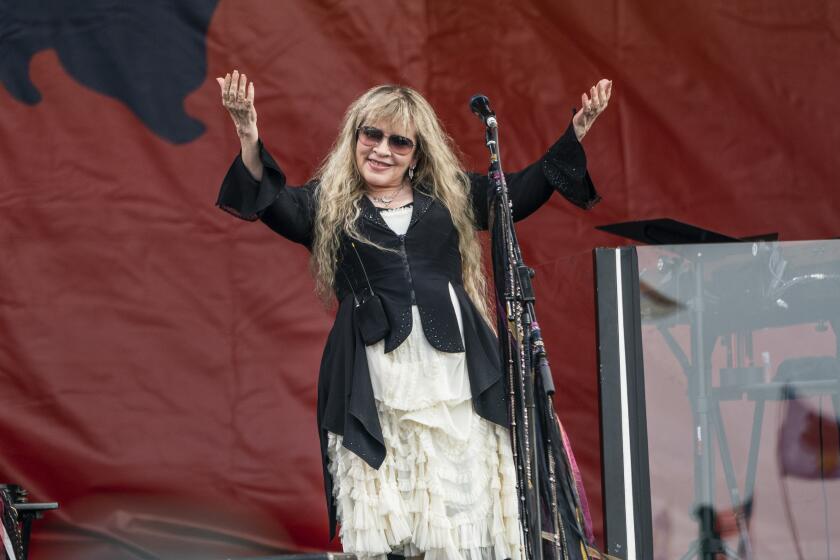Pianist Mike Garson debuts ‘Symphonic Suite for Healing’

Mike Garson obviously takes the piano very seriously, but he can chuckle over some of the contradictory paths that a versatile mastery of the keys has led him down.
Maybe the unlikeliest of all is the one he’s embarking on Saturday at Segerstrom Concert Hall in Costa Mesa, where he’ll lead 44 instrumentalists, augmented by a 55-voice children’s choir, in the premiere of his “Symphonic Suite for Healing.”
Even an accomplished musician like Garson, who’s best known as a key sideman during David Bowie’s 1970s rise to superstardom but who usually plays jazz or a jazz-classical fusion when left to his own devices, can laughingly confess that what he’s doing isn’t brain surgery or as important as finding a cure for cancer.
CRITICS’ PICKS: What to watch, where to go, what to eat
But now he’s partnered with Dr. Christopher Duma, a Newport Beach physician who does brain surgery routinely (with rock music piped into the operating room) and who is, indeed, trying to find new treatments for brain cancer and neurological conditions such as Parkinson’s disease and Alzheimer’s.
Duma’s nonprofit Foundation for Neurosciences, Stroke and Recovery commissioned Garson to write “Symphonic Suite for Healing,” and Duma road-tested preliminary recordings of the music with 100 of his patients to see which of the pianist’s 30 compositions helped them feel better or, in certain cases, worse.
The project is ambitious: a $300,000 budget to compose the music and rehearse and perform the concert while capturing it with audio and video recordings that Garson and Duma aim to make available to patients in hospitals and other therapeutic settings. Duma says the intent is also to raise general awareness of music’s medical potential while exploring possibilities for further research into how it can help improve life for people with neurological conditions.
Garson, 68, was clad all in black during a recent interview at his hillside home in the San Fernando Valley community of West Hills, and with his shaved head one could be tempted at first glance to size him up as a consciously arty type. But not after he begins talking.
What comes out is pure Brooklyn, even though he’s been a Valley resident since 1979. Coming up in Flatbush tends to inoculate against pretentiousness, and so it seems with Garson.
Sitting on the patio between his house and the former horse barn he converted into a recording studio, he mentioned in passing that one of his many piano students was the late Nicky Hopkins, who came to him in the early 1980s for jazz pointers in hopes of breaking into film composing.
PHOTOS: Unexpected musical collaborations
Hopkins sat at the pinnacle of rock pianism during what was almost inarguably the peak era of rock creativity, recording brilliantly with the Beatles, the Rolling Stones, the Kinks, the Who, the Yardbirds and the Jeff Beck Group when they were all in their prime. Although Garson makes nothing of it, if anything ever certified someone as the piano player’s piano player, teaching Nicky Hopkins would be it.
He can’t help laughing a bit about the anomalous side of his latest career move — and it’s been a career with its share of anomalies.
Starting at age 14, Garson spent seven summers playing Borscht Belt resorts in the Catskills, where he’d back the likes of Jackie Mason and Mel Torme. Enlisting in the Army as a music specialist “because I was going to get drafted and I did not see myself with a gun,” Garson found himself marching down Manhattan’s 5th Avenue on parade, beating a glockenspiel.
In the 1980s, he plinked a piano for the “Pee-wee’s Playhouse” children’s show on CBS. The day after rocking behind Bowie at New York’s Madison Square Garden during the ‘70s, Garson recalls, he had a moonlighting gig “schlepping a heavy Fender Rhodes [electric piano] through the door to play a bar mitzvah in Long Island.”
After his discharge from the Army in 1967, Garson made his way as a jazz musician and piano teacher in New York while also establishing rock music credentials with Brethren, a band whose manager, Sid Bernstein, had promoted the Beatles’ famous 1965 concert at Shea Stadium.
INTERACTIVE: Discover songs of L.A.
A recording engineer who’d been in on an avant-garde jazz session involving Garson touted him to Bowie and guitarist Mick Ronson, leader of the singer’s backing band, the Spiders from Mars. They needed a pianist for the American leg of the 1972 “Ziggy Stardust” tour — a career-making landmark of rock theatricality in which Bowie presented himself as an androgynously ambisexual alien. The audition lasted less than a minute, Garson recalls, before he was handed the gig. He played on Bowie’s next four albums, and a 1974 tour that cemented the singer’s stardom. Bowie would call him back periodically thereafter, most recently for a brief set in 2006 at a benefit concert in New York for AIDS-stricken African children.
“His playing is like Rachmaninoff on acid, don’t you think?” Bowie told the Sydney Morning Herald during a 1995 Australian tour with Garson in his band. Nine Inch Nails, Smashing Pumpkins and No Doubt are among the younger stars who concurred, enlisting Garson for recording sessions, concerts and, in the case of Billy Corgan of Smashing Pumpkins, as co-composer of the soundtrack to “Stigmata,” a 1999 horror film.
The record-buying masses first pricked up their ears for Garson when he threw hammering staccato riffs from “Rhapsody in Blue,” a dram of “Tequila” and assorted avant-garde atonal maneuvers onto the canvas of Bowie’s 1973 song “Aladdin Sane,” the title track of his first album to reach No. 1 in Britain and crack the Top 20 in the United States. The 90-second piano solo, over a surging, two-chord guitar vamp borrowed from the Drifters’ “On Broadway,” evoked a mind in frightening disarray.
“Bowie’s son [filmmaker Duncan Jones] confided in me that, ‘When I was 8 or 9. I was petrified of the solo, it gave me nightmares,’ ” Garson said with a laugh, noting that fans email him about the song all the time.
And now here he is, 41 years after “Aladdin Sane,” embarking on a campaign to promulgate music intended to produce exactly the opposite effect. “This,” he said jokingly, “is my amends project” for having been so scary.
It isn’t Garson’s first spiritual mission in the music world. In his early days with Bowie, he tried to convert the singer and the three other Spiders from Mars to Scientology, a faith Garson had been introduced to in 1970 by fellow jazz pianist Chick Corea.
“I was a little over the top in my dissemination,” he says now. “I showed [Bowie] the ‘Dianetics’ book one day, but he wasn’t interested.” Ronson, who died in 1993, bassist Trevor Bolder, who died last year (both from cancer) and drummer Mick “Woody” Woodmansey all gave it at least a look, and with Woodmansey it took.
Garson himself decided in the early 1980s that he needed a more self-tailored spiritual approach. “I don’t have any regrets [about Scientology]. There was some very valuable information I gained. We are all channeling this oneness that is there, as long as we don’t get into the negative thing that’s connected with being human, which is arrogance.”
Music’s healing effect has been documented since ancient times, going back, in Western culture, to the Hebrew Bible’s account of how the tormented King Saul “was refreshed, and was well, and the evil spirit departed from him” after the young David serenaded him on the harp. Garson said the idea of music as a potentially healing force began to emerge in his composing about 20 years ago.
PHOTOS: Arts and culture in pictures by The Times
He’s seen firsthand how music has helped the progress of his autistic 10-year-old grandson, Jacob, who’s also benefited from other therapies. “I started playing piano for him [when he was agitated], and felt him melt into my leg,” recalled Garson, who met Susan, his wife of many years, when she was vacationing in the Catskills as a teenager in the 1960s and heard him play. “I’ve seen with my own eyes that music produces a calmer temperament. It’s therapeutic for him.”
Garson also was impressed by television coverage of how music therapy helped former Arizona Rep. Gabrielle Giffords regain the ability to speak after she was shot in the head in a 2011 rampage at a meeting with constituents that left 13 people wounded and six dead.
“My intention got stronger,” he said — enough to invite Duma to dinner about two years ago to discuss how to proceed. They’d become friendly several years earlier when the neurosurgeon invested in a start-up company that aimed to provide online video music lessons in 3D. Garson, who began giving piano lessons when he was in his teens and still does, was going to anchor the instruction, but the company soon failed.
The pianist, who had wanted to become a doctor during his days at Brooklyn College until he found he couldn’t stand dissecting a pig, connected with the Manhattan-raised physician who’d studied classical piano for nine years and continues to perform on keyboards at parties and medical fundraising events with an Orange County rock band called Vital Signs.
Duma’s operating room credits include possibly having saved classical pianist Andre Watts’ life, not to mention his performing career, after he suffered a potentially fatal brain hemorrhage while in Costa Mesa in 2002 for a concert with the Pacific Symphony. He’s also been involved in researching new treatments for brain cancer and Parkinson’s disease. Bringing Garson’s music-healing work under the umbrella of the foundation he’d launched in the mid- 2000s, Duma, 54, conducted what he admits was a “rudimentary” study to test its potential.
Each patient listened on headphones in Duma’s office to a two-minute segment of three of the pieces Garson had written for possible inclusion in “The Symphonic Suite for Healing.” They rated the music on how they liked it and how it made them feel, Duma said, and his Parkinson’s patients took a dexterity test both with the music and without to see if it helped their performance.
Compositions that rated high became potential candidates for the 12-part suite. At least one playfully skittering piece got tossed after some patients said it made them feel anxious. The keepers include a high-energy opening fanfare and closing affirmation, a tender jazz-pop lullaby, and “The Gratitudes,” a series of quiet classical piano improvisations in honor of Jacob, one of Garson’s six grandchildren.
Duma, who’d served five years on the board of the Philharmonic Society of Orange County, sought advice from Dean Corey, its artistic director, and the concert is taking place under the Philharmonic Society’s aegis.
The performers include a core of jazz musicians hand-picked by Garson, among them Jim Walker, a former principal flute player for the Los Angeles Philharmonic who’s teamed with him since 1982, when they formed the jazz-classical band Free Flight. The program will include improvisations on Bowie’s “Space Oddity” and music by Paganini, George Gershwin and Dave Brubeck before intermission, followed by the premiere of “The Symphonic Suite for Healing.”
One of Duma’s Parkinson’s patients will dance a tango during the performance; the neurosurgeon said she normally has difficulty walking, but music eases her symptoms to the point where she can dance gracefully.
The project’s approach does not align closely with the field of music therapy as it’s taught in 73 college-degree programs in the United States, including Cal State Northridge.
That form of treatment is typically a one-on-one endeavor between a therapist and a patient, said Al Bumanis, spokesman for the American Music Therapy Assn. Therapists assess a patient’s individual needs and determine what styles of music and what kind of singing or instrument-playing exercises might work. It’s typically a musical interaction, Bumanis said, rather than just a listening experience using recordings.
Still, Bumanis said, “it’s great to have composers looking into this.” Jazz guitarist Stanley Jordan has studied music therapy, he said, and jazz violinist Regina Carter used some of her $500,000 MacArthur Foundation “genius grant” in 2006 to take an introductory course in it, after which she added hospitals to her performing itinerary.
Garson is thinking big and humbly at the same time. “My idea is to pump it into all the patients’ rooms around the world. We want to have music rooms at hospitals, just like there’s a chapel at hospitals.”
But he says he’ll be pleased even if the results aren’t always as dramatic as making Parkinson’s patients dance, agitated autistic children relax or suicidally depressed people feel hopeful enough to go on.
“I envision the music doing whatever’s needed by the person receiving it,” he said. “If they’re just a little depressed and then feel better, I’m happy.”
Mike Garson, “The Symphonic Suite for Healing.” 8 p.m. Saturday, Segerstrom Concert Hall, 615 Town Center Drive, Costa Mesa. $25 to $150. (949) 553-2422 or https://www.philharmonicsociety.org.
More to Read
The biggest entertainment stories
Get our big stories about Hollywood, film, television, music, arts, culture and more right in your inbox as soon as they publish.
You may occasionally receive promotional content from the Los Angeles Times.







